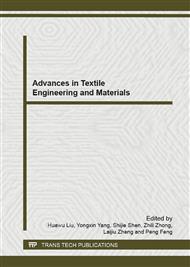p.839
p.844
p.849
p.855
p.859
p.864
p.869
p.873
p.878
Research Progress in Nano-Cellulose Modification
Abstract:
As an environmentally friendly material prepared from renewable natural resources, nano-cellulose demonstrates excellent properties, including high crystallinity, high purity, high surface area, unique optical properties, and high Young's modulus. Furthermore, it has the advantages of bio-based materials such as light-weight, bio-degradable, bio-compatible, and renewable. Therefore, the nano-cellulose shows a great potential for developing new composite materials with high performances. This paper summarizes the ways for chemically modifying nano-cellulose to obtain better dispersion and improve its compatibility with nonpolar or hydrophobic matrices in nano-composites.
Info:
Periodical:
Pages:
859-863
Citation:
Online since:
December 2012
Authors:
Keywords:
Price:
Сopyright:
© 2013 Trans Tech Publications Ltd. All Rights Reserved
Share:
Citation:


